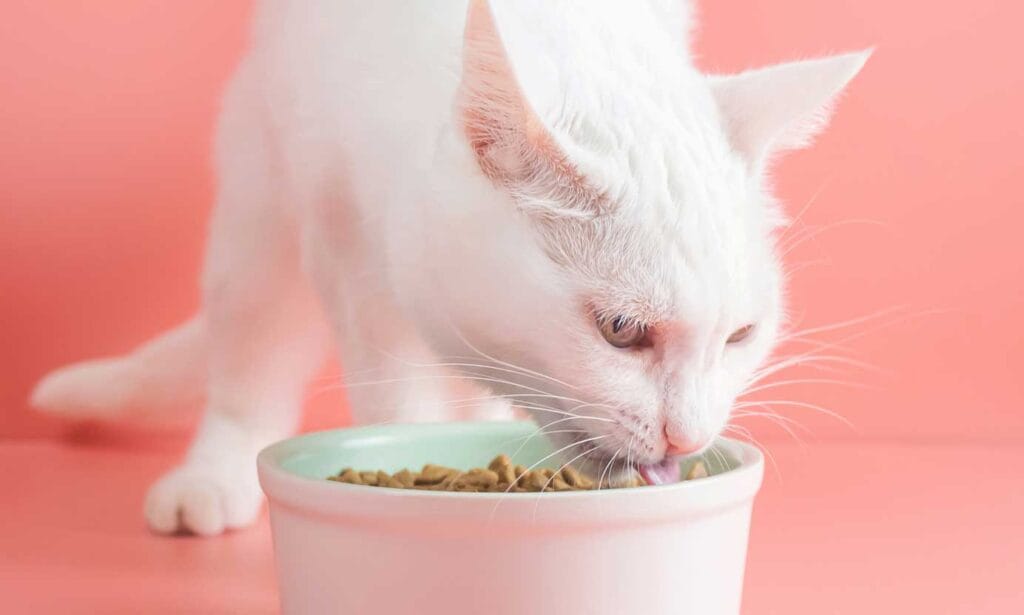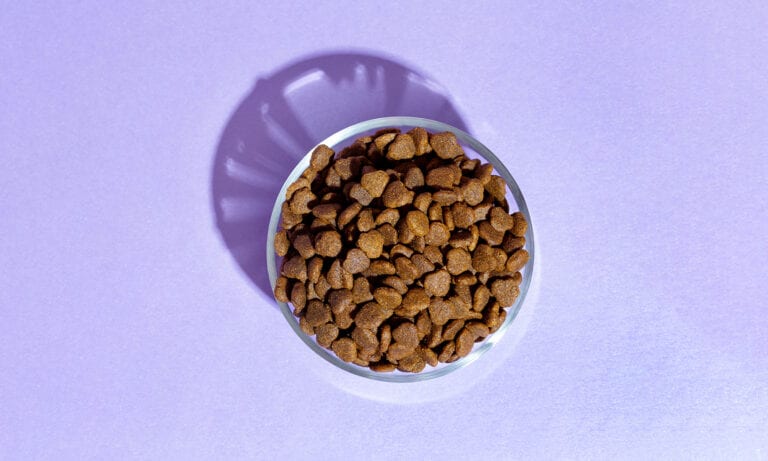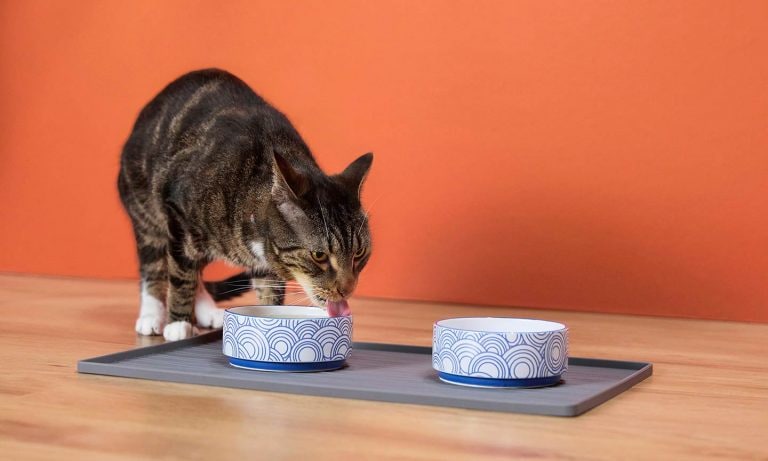As our feline companions weave their way around our feet and into our hearts, the quest to ensure their vitality and longevity takes center stage. To achieve this goal, some pet parents are turning to natural cat food, enticed by its promise of high-quality, wholesome ingredients. But what exactly does “natural” mean? And more importantly, should you consider this type of food for your kitty?
We spoke to a vet expert to answer these questions and get their top recommendations for natural cat food.
Click to jump to each section:
What Is Natural Cat Food?
In the context of pet food, the term “natural” is regulated by the Association of American Feed Control Officials (AAFCO), an organization that sets standards for both pet and livestock feed in the United States.
The AAFCO defines a “natural” pet food as:
“A feed or feed ingredient derived solely from plant, animal, or mined sources, either in its unprocessed state or having been subject to physical processing, heat processing, rendering, purification, extraction, hydrolysis, enzymolysis, or fermentation, but not having been produced by or subject to a chemically synthetic process and not containing any additives or processing aids that are chemically synthetic except in amounts as might occur in good manufacturing practices.”
Translation? Natural cat food should not consist of ingredients that are produced by or subjected to a synthetic chemical process. So, if a food contains artificial preservatives, flavors or colors, the term “natural” cannot be used.
What Ingredients Are in Natural Cat Food?
Protein Sources
Cats are obligate carnivores, so animal protein is the main ingredient in any cat food. This might include chicken, turkey, fish, beef, lamb, rabbit, duck and organ meats. Meat meals and meat byproduct meals can also be included in natural cat foods. Ideally, choose a natural cat food that has real meat as the first ingredient.
Fruits and Vegetables
While cats don’t need produce to thrive, some natural cat foods may include small amounts (typically 5 percent or less) of fruits and vegetables. Common additions include carrots, pumpkin, blueberries and cranberries, all of which supply health-promoting antioxidants and fiber.
Carbohydrates
Some natural cat foods contain grains such as brown rice, barley or oats. However, others may be grain-free and include small amounts of alternative carbohydrate sources, like sweet potatoes, potatoes or legumes. A cat might be fed a grain-free diet if they have grain allergies, digestive issues or extra weight.
Fats
Fats are necessary for a cat’s overall health. These may come from the protein sources or be added as fish oil or flaxseed, which provide omega-3 and omega-6 fatty acids.
Added Nutrients
Although not natural, the AAFCO allows cat food with added vitamins, minerals and amino acids (iron, potassium, taurine, etc.) to be labeled as natural. This is because cats need certain nutrients in certain amounts for optimal health. When synthetic supplements are added, the packaging will have a disclaimer saying the food is “natural with added vitamins and minerals.”
What Are the Benefits of Natural Cat Food?
When carefully formulated and balanced, natural cat food offers several potential benefits for your feline companion. According to Dr. Bethany Hsia, DVM, co-founder of CodaPet in Clovis, California, these might include:
- Improved skin and coat appearance
- Higher energy levels
- Better weight management
- Brighter eyes
- Reduced food-related allergies
- Reduced health problems or an improvement in existing conditions
- Better digestion, increased absorption of nutrients and healthier-looking stools
- Potential for a better quality, longer life
When Might a Vet Recommend Natural Cat Food?
Veterinarians might recommend natural cat food in several scenarios, Dr. Hsia says. The most common include:
- Food allergies and intolerances: Cats with food allergies or intolerances may benefit from natural cat food, especially if it has limited ingredients, as this can help identify and avoid allergenic ingredients.
- Weight management: If a cat is overweight or obese, a vet may recommend a natural diet that’s high in protein and low in carbohydrates to help manage weight and prevent related health issues.
- Skin and coat health: A vet may suggest a natural diet if a cat has a dull coat or skin issues. High-quality, natural ingredients often promote healthier skin and a shinier coat due to their higher nutritional value.
- Digestive issues: For cats with digestive problems like IBD, a vet might recommend a natural diet with limited ingredients to help identify food intolerances and promote better digestive health.
- Older cats or cats with specific health conditions: Senior cats or those with conditions such as kidney disease, liver disease or diabetes might benefit from natural cat food tailored to their unique nutritional needs.
Remember, what works best for one cat may not work for another. Therefore, it’s always essential to consult with your veterinarian before making significant changes to your cat’s diet.
Vet-Recommended Natural Cat Food
For overweight and pre-diabetic cats, one of Dr. Hsia’s top recommendations is Original Instinct real chicken pate. When fed in appropriate amounts, she’s seen this wet cat food help her furry patients lose weight and improve their blood glucose levels.
Made with all natural ingredients, this savory, whole-food recipe contains 95 percent chicken, turkey and chicken liver; 5 percent fruits, veggies and other nutritious ingredients, like flaxseed; and essential vitamins and minerals. It’s also free of grain, potato, corn, soy, wheat, artificial colors and preservatives.
Dr. Hsia also recommends high-quality, protein-rich cat food such as this one for kitties with hepatic lipidosis (aka fatty liver syndrome). This food provides necessary amino acids for liver repair and helps maintain muscle mass often lost in these cats.
Blue Buffalo Wilderness Wild Delights Flaked Wet Cat Food is low in carbs and high in moisture and protein, making it another great option for cats with obesity, diabetes and hepatic lipidosis. Wet cat food in general is also great for hydration, which can help cats with constipation.
And although Dr. Hsia cannot personally attest to its taste, many pet parents have reported their picky eaters go crazy for the chicken and trout flavor.
At the heart of this food is high-protein chicken and trout, both of which are known for their irresistible flavor and essential nutrients. These proteins are paired with a wholesome blend of fruits, veggies, and essential vitamins and minerals.
This formula contains all-natural ingredients and is free of grain, gluten, byproduct meals, corn, wheat, soy, artificial flavors and preservatives.
For cats with inflammatory bowel disease (IBD), Dr. Hsia recommends limited-ingredient diets, like Natural Balance Limited Ingredient dry cat food.
IBD in cats involves chronic inflammation of the digestive tract, leading to symptoms such as vomiting, diarrhea and weight loss.
The exact cause of IBD is unknown, but it’s thought to be a reaction to proteins in the diet or changes in the balance of intestinal bacteria, among other factors.
A limited-ingredient diet is specially formulated to reduce the number of potential allergens or irritants a cat is exposed to through food. This kibble contains a single protein source (real chicken) and a limited number of carbohydrate sources—in this case, green peas, chickpeas and lentils, which help maintain your kitty’s digestive health.
Natural vs. Organic Cat Food: What’s the Difference?
It’s important to note that a cat food labeled “natural” does not necessarily mean it’s organic. Organic cat food complies with rules established by the USDA (United States Department of Agriculture) for organic human food manufacturers, which include:
- The crops are grown without the use of synthetic fertilizers or herbicides.
- The animals raised for meat, milk or eggs are fed organically grown feed.
- The manufacturing operations are inspected by USDA-accredited companies.
If a cat food contains at least 95 percent organic ingredients, it can display the USDA organic seal and certified organic statement. If a cat food contains at least 70 percent organic ingredients, the label can say “made with organic ingredients.”
How Do I Switch My Cat’s Food?
Deciding to switch to natural cat food is a significant step towards prioritizing your feline friend’s health and well-being. But how do you seamlessly make the switch?
Changing your cat’s diet should be done gradually to minimize digestive upset. This also allows your cat time to acclimate to the taste and texture of the new food, making them more likely to accept the change.
The new food—in this case, natural cat food—should be introduced incrementally over a period of about seven to 10 days. Here’s a recommended schedule to guide your cat’s transition:
Days 1-3
Start by mixing 25 percent of the new natural cat food with 75 percent of your cat’s current food. Monitor your cat’s response in terms of appetite and any signs of digestive discomfort.
Days 4-6
Gradually increase the new food to 50 percent, mixing it with 50 percent of the previous food.
Days 7-9
Further increase the new food to 75 percent, mixing it with 25 percent of the previous food.
Day 10 and onward
By now, your cat should be ready to eat 100 percent of the new food.
If your cat experiences gastrointestinal upset, such as vomiting or diarrhea, during the switch, slow down the transition or consult with your vet.
More about feeding your cat:
Share:












